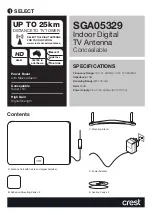
4.1 General cabling guidance
Cable types and length
It is important to use cables of the appropriate type
and length
• Unless otherwise stated use only standard cables
of the correct type, supplied by Raymarine.
• Ensure that any non-Raymarine cables are of the
correct quality and gauge. For example, longer
power cable runs may require larger wire gauges
to minimize voltage drop along the run.
Routing cables
Cables must be routed correctly, to maximize
performance and prolong cable life.
• Do NOT bend cables excessively. Wherever
possible, ensure a minimum bend diameter of 200
mm (8 in) / minimum bend radius of 100 mm (4 in).
100 mm (4 in)
200 mm (8 in)
• Protect all cables from physical damage and
exposure to heat. Use trunking or conduit where
possible. Do NOT run cables through bilges or
doorways, or close to moving or hot objects.
• Secure cables in place using tie-wraps or lacing
twine. Coil any extra cable and tie it out of the way.
• Where a cable passes through an exposed
bulkhead or deckhead, use a suitable watertight
feed-through.
• Do NOT run cables near to engines or fluorescent
lights.
Always route data cables as far away as possible
from:
• other equipment and cables,
• high current carrying ac and dc power lines,
• antennae.
Strain relief
Ensure adequate strain relief is provided. Protect
connectors from strain and ensure they will not pull
out under extreme sea conditions.
Cable shielding
Ensure that all data cables are properly shielded
that the cable shielding is intact (e.g. hasn’t been
scraped off by being squeezed through a tight area).
Suppression ferrites
• Raymarine cables may be pre-fitted or supplied
with suppression ferrites. These are important for
correct EMC performance. If ferrites are supplied
separately to the cables (i.e. not pre-fitted), you
must fit the supplied ferrites, using the supplied
instructions.
• If a ferrite has to be removed for any purpose (e.g.
installation or maintenance), it must be replaced in
the original position before the product is used.
• Use only ferrites of the correct type, supplied by
Raymarine or its authorized dealers.
• Where an installation requires multiple ferrites to
be added to a cable, additional cable clips should
be used to prevent stress on the connectors due
to the extra weight of the cable.
Connections to other equipment
Requirement for ferrites on non-Raymarine cables
If your Raymarine equipment is to be connected
to other equipment using a cable not supplied by
Raymarine, a suppression ferrite MUST always be
attached to the cable near the Raymarine unit.

































